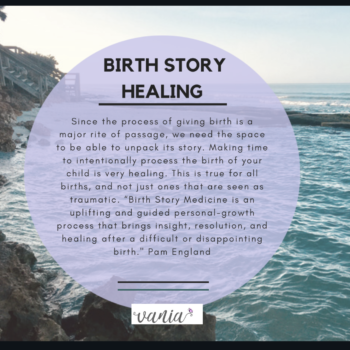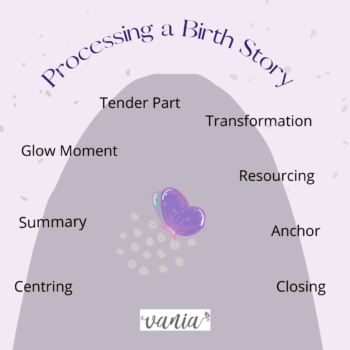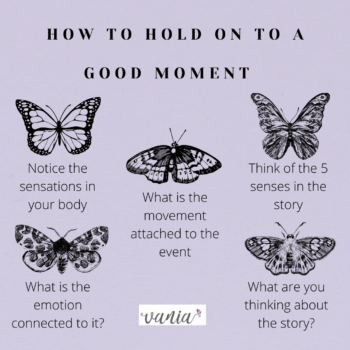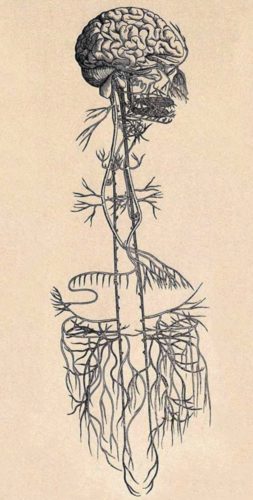Birth Story Processing is an important way to honour both the transition into parenthood, as well as heal from the intense experience that is called birth. While not all births are traumatic, they can be quite intense and it is the birther’s definition and interpretation of the birth that defines it. The impact on birth lingers both in the birther and the baby for years. This is one reason it deserves more intentional holding space, as well as honouring this rite of passage and reclamation of our body.
 Pam England, who wrote the transformational book Birthing from Within, also created the concept of Birth Story Medicine. As it is meant to be a single-session process to debrief a birth, it is not considered therapy. It ties in concepts of Solution-Focused Counselling (have you heard of the Miracle Question?), as well as archetypes, expressive arts prompts, mythological story-telling, and somatic resources. In the end, the process aims to help the birther find a way to reclaim the story in a more positive and anchoring way.
Pam England, who wrote the transformational book Birthing from Within, also created the concept of Birth Story Medicine. As it is meant to be a single-session process to debrief a birth, it is not considered therapy. It ties in concepts of Solution-Focused Counselling (have you heard of the Miracle Question?), as well as archetypes, expressive arts prompts, mythological story-telling, and somatic resources. In the end, the process aims to help the birther find a way to reclaim the story in a more positive and anchoring way.
While this is a great start, not all births or people can complete the process in one session, and the process isn’t as trauma-informed as it should be. It also is focused more on story than giving voice to the body, where the actual event of birth happened. At times, the process can feel a bit too fast, and i worry about the cultural appropriation of using references that are not from the birthers or listener‘s lineage.
It is important to note that not all birthers are women, and more racialized and marginalized birthers face greater obstacles to having a successful and safe birth. Birth Story Processing work needs to also know this impact and intersection. That’s why i have noticed the need to intentionally incorporate more body-based steps in the process. Further, it may take more time than one session, especially if there is trauma present. This is where the good work of Sensorimotor Psychotherapy and Somatic Experiencing come in. Both modalities are intuitively body-based (bottom-up) and trauma-focused.
Birth Story Medicine works in significant stages – There are distinct stages in Sensorimotor Psychotherapy as well – building a Container, Accessing what to tend to for the Session, Processing the work, Transformation phase (where the magic happens) and Integration. This is called CAPTI for short. After working with both models, I have found a way to integrate and adapt them into my own process:

Somatic-Informed Birth Story Process Stages:
1. Intro and Centreing
2. Overall Summary of Story
3. Choose a Moment that is a Glow Memory
4. Choose a Tender (hard) Moment or Part
5. Transformation Process – trauma resolution work
6. Resourcing
7. Integration – Anchor it
8. Closing
Centring
The first few stages of the process honour the rapport and trust that is needed to build before jumping into the work of healing. And yet they are crucial for setting the foundation. So take time to centre and ground the birther – create an environment of safety and comfort. Have resources to help ground, both somatic and physical ones.
Summary
Most people get to just summarize the story. They miss out on the good parts, and the witnessing a good listener gives them. I know when clients and friends alike get excited when i say i’m not in a rush to hear the Coles Notes of the story. I’m here for it all, in its fullness. A summary, though is helpful for the listener especially if it’s the first time hearing it. It should be about 3-5 minutes long, and is a chance to get a heads up about the ending. This helps set the pace and for the listener to gather any resources needed if the story teller gets overwhelmed or re-activated in recalling the story.
Glow Moment
One element of processing the story is to find the gifts – Deb Dana refers to these as your ‘Glimmer or Glow Moments.’ This helps give access to the fullness of the story, both the harder moments that are more typically stored in the body (as a form of protection that ironically overdoes their job) alongside the beautiful moments that also deserve to be stored as a postcard photo to mark the event. As animals, humans are like all other creatures that birth. Except we also have a Negativity Bias that lodges the harder memories to help us learn from the experience and protect us. And yet overtime, we start to skew those memories too.

Pat Ogden created a resource called Building Blocks – Core Organizers for a Good Moment. They are steps to help someone truly hold on to a special moment that happened. True to somatic therapy process, they start in the body – the sensations, movements and 5 senses. Only after the memory is felt in the body does it get to the place of emotion and thought. So, when holding on to a sacred, gentle, or special memory from the birth.
Tender Part or Moment
While we cannot go back in time to do the birth over, we can still heal where the story is stuck in our body. For instance, it could be doing the first stage of labour when someone said something and the birther felt shutdown. It could be during birth when the birther experiences tears during the birth of the baby’s crown. It could be after when the placenta had complications and there was an excess of blood. Using an IFS framework, it can also be a Wounded Part of you that is trying to protect you, and yet is not working with an updated agenda. There is an opportunity for a do-over. Any of these moments can benefit from some healing body work even after the birth. It is a way of completing the cycle that was not tending to in the first place. This is very similar to trauma resolution work for people who have experienced violence; they recreate a moment when they wish they could have felt safe to block a fist, roll away, or punch someone.
When we find a moment to unpack, process and heal, it’s called Framing, to explicitly choose this moment to delve into. This is where the birther’s explicit consent to stay in hard memory comes in. This is also a corrective emotional experience that Parts Work can support, as a way to update Parts and give them the opportunity of a Do-Over.
Transformation and Resourcing
 In case you haven’t heard of it, there has been a lot of (rightful) information about Polyvagal Theory. It is this wonderful nerve that acts as a pathway from our brain stem to our perineum. It provides all sorts of support to our body and how we react to the world. Since it so solidly lives in the pelvis as well as the brain, i love that I have seen how the theory can show up in action during childbirth. There are 3 stages of labour, just as there are 3 parts of Polyvagal Theory: The Sympathetic Nervous System (the good ole Reptilian Brain) and the 2 parts of the Parasympathetic Nervous System (Ventral Vagus Nerve and Dorsal Vagus Nerve) make up Polyvagal Theory. Knowing how the body responds to stress and danger helps us tend to where we are in the Window.
In case you haven’t heard of it, there has been a lot of (rightful) information about Polyvagal Theory. It is this wonderful nerve that acts as a pathway from our brain stem to our perineum. It provides all sorts of support to our body and how we react to the world. Since it so solidly lives in the pelvis as well as the brain, i love that I have seen how the theory can show up in action during childbirth. There are 3 stages of labour, just as there are 3 parts of Polyvagal Theory: The Sympathetic Nervous System (the good ole Reptilian Brain) and the 2 parts of the Parasympathetic Nervous System (Ventral Vagus Nerve and Dorsal Vagus Nerve) make up Polyvagal Theory. Knowing how the body responds to stress and danger helps us tend to where we are in the Window.
So, why do we need to know about Polyvagal Theory (or even the Window of Tolerance) in reference to birth and healing from it? When we know more about how our body and nervous system step in to help us under duress, a new experience or under threat and pain, this knowledge enables us to know what to do for our Self. For instance, do you know if you respond to surprise/pain/fear in a Flight, Fight, Fix(fawn) or Freeze way? We don’t have to endure trauma in our life to have an instinctual response. Our nervous system kicks in to help us grapple with something tat is too much to bear or is overwhelming. If you want to know more about the 4 F’s place in birth, check out my birth story of my youngest child, where i share this more.
The body stores these memories, as well as the brain, That is why it is important to notice what sensations and symptoms are embodied in the body. There are techniques in somatic-based therapies that help connect to that body story. Some are voluntary movements. For instance, completing a stuck movement that was never finished. It could be screaming (when told to be quiet), changing positions, or pushing and bearing down. Another transformative process is the technique of Sensorimotor Sequencing. This is where the body auto-regulates, and follows the sensation that happens intuitively in the body. Please Note: While this is the bulk of the work, it is hard to explain it in detail in this summary. If you want to learn more about somatic therapy, check out where you can get properly trained first.
Anchoring
This final step of trauma processing is where the integration happens, where the tender or hard moment gets put back in the story in a less activated way. There are various resources that work to do this – savouring the transformation that happened in the session, finding other resources, and also discovering an anchor that can act as a symbol of this transformation.
Some Somatic Ways to Anchor:
* Take a long bath, a lower back massage, or walking to get even just 5% more comfort in my body
* Pay attention to your edges where sitz bone meets chair; do a mindful body scan
* Vagus stroke
* Find inspiration from archetypal or mythical stories (i.e. Inanna)
* Do a Release ritual that brings in an intentional practice with the elements
* Go deeper into body – learn some meditation, things that help you notice interoception into fascia, bone, or muscle
* Sway, push a wall, balance on a broom stick rod, play with a movement that feels organic and intuitive in the here and now
Sometimes the work is not just recreating a moment but also healing work that uses the parasympathetic part of your brain where creativity thrives. As our brain cannot think when it is under duress – It just goes into flight or fight – it is very cathartic to spend time after carving out some creative alternate endings. Drawing out a scene, writing an apology or forgiveness letter, or using non-dominant hand writing is very transformative. Expressive Arts Therapy is a tool that uses visual arts, dance, music, role play, and writing in an intentional way, to get a different way to express ourselves with something we may be stuck on. It combines both parts of our brain, which helps to heal in a holistic way. It is also very empowering to have a new alternate ending and multiple truths to a story that had been full of pain and internalized shame. Further, is a form of reflective self-care and not art class or arts and craft – the process matters more than the finished product. Our whole body does the work, and feels the expression. It is a trauma-informed modality and can be used with a feminist lens.
As a Narrative therapist myself, i do appreciate the place for story. Brene Brown’s work on courage, vulnerability and shame (Rising Strong) is a wonderful reminder of the importance of holding space for our rites of passage. She describes the process in 3 stages: The Reckoning – walk into your story; The Rumble – owning our story and The Revolution – write a new ending. Internal Family Systems is also a wonderful addition to Birth Story Healing – when we recognize, acknowledge and hold space for Parts that showed up during a birth, we heal and integrate them. That Firefighter, Goddess, Warrior, Inner Child or even Manager in you was trying to do the best job to help birth your baby earthside.
Closing
After spending time holding space for someone’s birth story, it is so important to also show the closing of the session in high regard and respect. Make sure to leave time at the end to incorporate all that was covered, especially the anchoring work. This also ensures that they are feeling stable and with a new felt sense of lightness or completion in their body.
So many of us assume that the birth does not matter, so the focus is on the health of the child and on the periphery, the mother. The transition from Maiden to Mother has become lost. There has been a resurgence of the word Matrescence, which highlights this rite of passage, and many groups are also doing important to work to reclaim the rightful place of birth story in our overall mental health and Resilience as new parents.
“Practice listening to your intuition, your inner voice; ask questions; be curious; see what you see; hear what you hear; and then act upon what you know to be true. These intuitive powers were given to your soul at birth.”― Clarissa Pinkola Estés, Women Who Run With the Wolves: Myths and Stories of the Wild Woman Archetype

